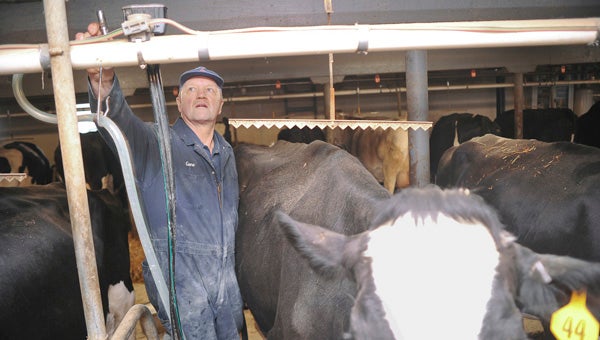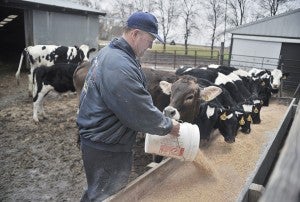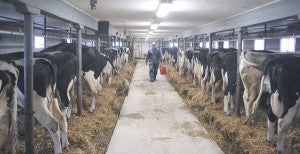Corn remains a strong venture
Published 9:23 am Monday, April 25, 2011

Dairy farmer Gene Anderson sets up for the night’s milking Thursday night. Anderson and other dairy farmers have been dealing with an at best, break-even dairy industry over the last three years. -- Eric Johnson/ Albert Lea Tribune
When farmers were thinking “knee-high, Fourth of July” last year, they were already up to their ears in corn.
Corn prices were healthy, yields were even healthier, and the entire agriculture industry saw changes.
Although 2011 output may not rival last year’s, grain prices may reach record highs as the international food market is hungrier than ever.
“The U.S. is the, pound for pound, gorilla in the corn business,” said Ron Frank, president of the Mower County Farm Bureau. Frank said the region’s producers are some of the best in the state, and there’s proof. Last year, farmers were planting corn as early as mid-April, which made for a very long growing season. One crop near Sargeant drew an award for 230.84 bushels per acre.
This year, farmers won’t likely plant until early May, but most of them are optimistic. If they have their corn in by May 10, they expect to have a good year. Even though production may not be as high, the sale price may increase — again.
Robert Nelson, who grows about 700 acres of corn and 500 acres of beans near Alden, saw corn sell for $4.50 to $4.75 a bushel. That price could surpass $5 or $6 in 2011. Bean prices have also been solid. However, Nelson said the record prices are a bit misleading. Input costs have increased as well.

Gene Anderson, of rural Sargeant, feeds his dairy herd Thursday evening before milking. -- Eric Johnson/ Albert Lea Tribune
Fertilizer, which dipped before last year, is on the rise again. Gas prices are high, which may not have a huge affect on the cost of off-road diesel, but it’s affecting farmers.
“It’s nothing to use 500 gallons of fuel a day,” Nelson said about using his tractors. “It’d be a lot less fun if you had a dollar gauge.”
And if it weren’t for the large corn production feeding the Ethanol industry, fuel could be 20 cents higher or more, Nelson said.
Most farmers have been fortunate, though. With the increase in input costs, crop prices have increased, along with beef, pork and sheep. Not everyone has been so fortunate, however.
Dairy
In the dairy industry, one could say the milk has gone sour. Milk producers have struggled for nearly three years in an economy that changed for them about six or seven years ago, according to Eugene Anderson, who milks 41 cows near Sargeant and is a member of the Mower County American Dairy Association.
“Ever since it’s been on the board of trade, it’s been a roller coaster,” he said.
Anderson and other dairy farmers have been waiting to make profits for nearly three years. He and others have been losing money, or breaking even at best.
Although the international market has been good to farmers in other industries, Anderson is upset about it in regards to milk. He said the U.S. imports too much milk, when it could buy its own source and help U.S. farmers.
“Why do we import all this if we have enough milk of our own?” Anderson asked.
He has more reasons to be upset, too. He explained how imported milk doesn’t go through as stringent of testing or abide by the same standards. That’s why Anderson still has pride in his product.
“My milk gets tested every day; it’s a safe product,” he said.
Many people complain about the price of milk and dairy products in stores, but Anderson said those retail prices are actually low. He doesn’t see how the fluctuations will stop if the U.S. keeps importing. And Anderson has even one more conundrum. He raises enough corn to feed his cattle, but he could be selling it all for a high price. However, if he sells it, he’ll have to purchase corn at a high price. He knows something needs to change, and he wants it to happen with those controlling the market and trade.
“They evidently don’t want other dairy farmers to make any money,” he said. “At some point in time, somebody better wake up. You’ve got to make some money milking cows.”
Pork
As a hog farmer, Don Larson is another guy who knows about high input costs. He, like Anderson, raises his own crops to feed his livestock. It doesn’t come close to feeding all of his hogs. All of Larson’s crops will feed about 20 percent of his hogs.
“Most farmers don’t raise enough to feed their hogs,” he said. “Those that do that, that’s a great deal.”
Larson said farmers can’t specialize in everything and be profitable. Although he and his father run Sargeant Grain Elevator, Larson specializes in hogs.
“You can’t be jack of all trades and compete,” he said.
Larson, who had been losing $40 to $50 per head on his hogs, has seen a drastic improvement. However, his prices have only risen to about $5 to $7 per hog. And rising grain prices make things difficult.
“No matter what your size, feed is such a huge cost in production of meat,” Larson said.
With corn being in more demand than ever and the government estimating 92.5 million acres of U.S. corn, Larson was lucky hog prices went up with the corn prices.
“If we didn’t have the price of hogs go up with the price of corn, we wouldn’t have a hog farmer left,” he said.
Studies show drastic increases in hog profits and prices, but Larson said the numbers are misleading. To him, it’s still a “nip and tuck” industry, and it is fluctuating like the dairy industry. He, like other farmers, views the situation from the world’s perspective. Americans are still eating plenty, even when food prices increase. Larson learned to appreciate what he has from his friend in the Philippines, who told Larson he doesn’t have to eat every day.
Beef
If there’s one thing that’s been better than raising corn, it could be raising beef cattle.
Ron Eustice, executive director of the Minnesota Beef Council, said the beef industry is pretty solid.
Currently, the U.S. is exporting about 12 to 15 percent of its beef, and profits have been solid for several years.
“Exports are at record-high levels, which is extremely important for the beef industry,” Eustice said.
Locally, farmers have been seeing that benefit.
“We wouldn’t have these kind of record prices without the exports,” Nelson said, who is also a beef farmer (farmer mentioned above).
However, exports alone won’t sustain the beef industry; and they may not have to. America is beef hungry, and the beef industry doesn’t completely rely on foreign markets.
“We can’t survive solely on exports; we’ve got to have a strong domestic market, which we do,” Eustice said.
Several other factors affect profitability, however. Land rent is at an all-time high, and farmers like Nelson, who raise Holstein beef cattle, pump a lot of grain into their livestock. They also buy milk replacer, supplemental drinks and medications for large populations of young calves.
Nelson, who buys around 80 calves at a time, said he has to carefully watch the animals because they are often five to 10 days old when purchased and very vulnerable.
“It’s not an exact science; you’ve got to be ready for trouble around the corner,” he said.
But others may want to pay attention to Nelson’s approach. Of 16 people on the state beef board, he’s the only one who operates the way he does — buying large lots of calves at very young ages and raising them all the way to market. At times, Nelson accumulates 700 to 800 cattle before selling some.
Nelson also isn’t afraid to say he’s been doing well. His approach is high-risk because the calves are susceptible to sickness, but it’s been working for him a long time.
“Because it is hard work and high risk and not everybody wants to do it, it leaves some profits in it for us,” he said.
But Nelson also raises corn and beans, knows about high feed costs — and the industry in general. That’s why he’s sympathetic toward the farmer who is having the toughest time of any right now.
“The poor old dairy guy; he’s just had tough going all the way,” Nelson said.






